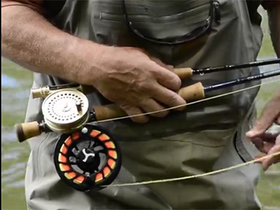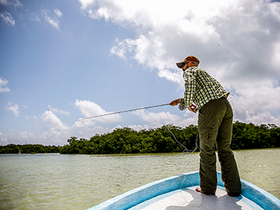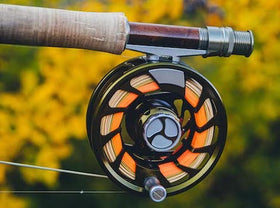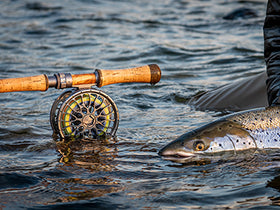.jpg)
It's amazing to at least have a chance at fish like this Huon River beauty so close to Tasmania's capital.
Tasmania is a wonderful place for a flyfisher. Home to thousands of lakes and rivers containing wild brown and rainbow trout, mostly set in stunning surroundings.
When I first moved here 20 years ago, I frequently found myself seeking the serenity of the famous highland lakes, camping in remote areas, spending days wandering around looking for trout sipping on duns or cruising the lake edges chasing frogs or baitfish.
Time moves on though, and so do commitments. Fulltime jobs, family and running my own fly-tying business, left the opportunity to ‘just pack up and head up the road for a few days’ more limited. It wasn’t really something I thought about, it’s just what happens in life.
When COVID struck a few years ago, I happened to be in the Nineteen Lagoons fishing on my birthday weekend. I’d had a great trip and caught some very memorable fish, so it came as quite a shock when less than 24 hours after my return, national parks and all the Hydro lakes were closed to public access. It was a strange feeling being shut out of all those waters I had spent many years fishing, and with no indication when I might be able to return.
Although the closure happened at the end of March, that left a good few weeks of the season – weeks which are often my favourite time. So now my attention turned to trying to find places I was still allowed to go. Truth be told, there were quite a few, but after further travel restrictions were imposed, accessing them became more difficult.
Without immediately realising it though, I was in a very fortunate position. I lived in a house on a bit of land, but more importantly, a little creek flowed through it. Before COVID restrictions, I hadn’t really thought much about that creek. Although I got the house water from it, and I’d occasionally sneak down to watch the little trout it held, I’d never really thought about fishing it.
.jpg)
Typical Hobart region creek trout - they're not all monsters, but they're all good fun.
Those last few weeks were really life-changing from a fishing point of view. Many hours were spent wandering up the tiny creek flicking dry flies and nymphs to little trout. That experience has influenced my fishing ever since.
In the business of life, I have become more reliant on finding places to fish closer to home. I would much prefer to spend my time fishing than driving, and over the last few years, I have revisited places I first fished when I moved here, and explored new ones. I’ve found really rewarding fishing, sometimes challenging fishing, and occasionally frustrating fishing. Either way, I’ve come to appreciate my local waters more than ever.
Trout fishing in the Hobart area can really be split into a couple of categories: the two big rivers, and all the other streams, ranging from medium-sized to tiny. While there are a couple of lakes as well, locally, I prefer the rivers.
The Big Rivers
Broadly speaking, there are two big systems that hold trout withing easy distance from Hobart: the Derwent River and the Huon River. Both hold a really good head of trout, and both hold trout that can take your breath away.
The Derwent
On the Derwent, the huge estuary is the main attraction. My pick when heading out to fish is usually the water between the famous Zinc Works and New Norfolk. There are plenty of angler access points right the way along the river, and they provide a lot of bank to spend an hour or two throwing flies.
There are trout right the way through the Derwent, and they can be found at all times of year. However, the times I fish for them are from winter into the start of spring. June can be a little quiet, but July and August see an increasing number of post spawners return to their haunts. (In contrast to many Tasmanian trout waters with a closed season, the Derwent downstream of New Norfolk bridge is open to fishing all year.) These trout are often supplemented between August and October when sea-run trout come back into the system. Both the post spawn fish and the fresh sea-run fish can hit streamers really aggressively, launching into the air when they feel the hook, and doing their best to get rid of it.
.jpg)
Reedy edges are a great place to prospect on the Derwent.
My approach for the Derwent estuary is quite simple; the priority being able to keep mobile and cover plenty of water. I prefer using a 7 or 8 weight rod and an intermediate line from the bank, a 12lb fluorocarbon tippet, and mostly Zonker-style flies. I often use very big flies of 15 to 20cm in length, prospecting right along the shore and against any reeds.
.jpg)
Derwent trout like a bit of orange.
These Zonker flies, weighted with a bead, dumbbells, or a few wraps of lead, provide a really enticing lure. Trout love the lifelike motion of the rabbit strip and I have developed a lot of confidence in these flies as searching patterns. I have also had success on Game Changer-type flies. Their ‘presence’ in the water, plus their movement, also attracts plenty of attention: they just take longer to tie, and I’m always heartbroken when I lose one to a snag!
.jpg)
Really big wets with a stinger are a surprisingly good option on the Derwent.
As far as colours go, I am sure most will work on their day. However, I find I get most interest in olive or barred olive, natural rabbit, or black. I also like to have a little bit of flash or an orange hotspot in there too.
Add waders, a decent landing net (some Derwent trout are very big!) and polarised glasses, and you’re ready to get the most out of a Derwent day.
.jpg)
Make sure you carry a big net!
Although there are good numbers of fish in the Derwent, they can also be the most frustrating trout I have ever fished for. Unlike their kin in fast, shallower streams, there is often no necessity for them to make split-second decisions about their next meal. There is no lack of food, with schools of small mullet and salmon, whitebait, other minnows, shrimp, crabs and all manner of other tucker to keep them well fed.
I have come to the belief that a lot of Derwent success is all about the reaction strike. Of note, I’ve also found that, while retrieves with a slow, short pull (as I often use on the lakes) do get some interest, usually the trout just follow, and follow, and follow… until they spook. Instead, I’ve found a much more vigorous retrieve, even a roly poly, seems to get them fired up a bit more. I say a bit, as you still get many trout that just follow.
.jpg)
Zonker flies are a good option on both big rivers, and also the other streams when flows are up.
As so often in streamer fishing, it’s very important to fish your fly right to the end of the retrieve. Regularly, the trout will have a lunge just as you are lifting out to recast, so it’s crucial to ‘fish’ the fly until it has to leave the water. (On the other hand, I find that stopping the retrieve to allow the fish to catch up usually results in them spooking.)
The Huon
The Huon is the other big local river I fish for trout. The Huon is very picturesque, and its tannin-stained waters are often deep and mysterious. It’s also usually a little more sheltered than the Derwent and can be a much more hospitable place to fish in wintery winds. My favourite areas to fish the Huon are below the Huonville Bridge (the Huon is open all year downstream of this bridge) and down to Port Huon. This area is rich in reed-lined banks, with plenty of ambush points for resident estuary trout and sea-run trout.
.jpg)
Huon River streamer eater.
The Huon, like the Derwent, can have spectacular runs of whitebait, and it really gets the pulse racing to watch trout smashing into these little baitfish. There are lots of ‘whitebait’ patterns that will work in these situations, but I favour an unweighted natural or grey Zonker. The most success I’ve had with these flies is casting into the swirls created by the trout (if possible!) and just letting the fly sink slowly. If the trout doesn’t take on the drop, then start a quick retrieve.
I find the trout in this part of the Huon are a little more accommodating than those in the Derwent. I don’t know if this is because the tannin colour reduces visibility and forces the trout to be more impulsive? Or, if the trout don’t have as much food available in the tannin-stained water, making them less ‘lazy’ than their Derwent cousins. I still find a quicker retrieve often gets more interest though.
I keep all my gear the same as when fishing the Derwent, and the times of year I fish the Huon are also winter and spring.
.jpg)
A boat is handy for access on the Huon, although not essential.
The Huon is often easier to fish from a boat, as a lot of the riverbank is privately owned. Although there are still some good angler access points, I find that they are a little harder to flyfish than the banks of the Derwent, and there are frequently large logs and snags to negotiate.
The small to medium-sized streams
By the time the new trout season opens in early August, I’ve usually had my fill of streamer fishing the bigger rivers and I’m keen to fish some more intimate water. Smaller rivers and creeks within easy reach of Hobart provide some really diverse fishing.
While lots of these systems have suffered in recent years from low water levels and cormorants, you can still find some exciting and worthwhile fishing.
The Tyenna
One of my favourite waters, and one that probably needs no introduction, is the Tyenna River. This really is a river that has it all. In the early parts of the season, if there is a decent flow coming down, I like to streamer fish using similar flies to the ones I use on the Derwent and Huon. Olive and black-coloured Zonkers, twitched through pools, or a tungsten-beaded Martin’s Minnow thrown into faster water, will often get the trout stirred up.
.jpg)
Brownie on a smaller Zonker.
If that isn’t producing, and if the water is safe enough to get into, I will Euro-nymph. The Tyenna is a particularly good river for nymphing and there are plenty of good runs. Even I can look as though I know what I’m doing! My favourite nymphs for the rivers are ones which have a hotspot of some sort. Tasmanian Devil nymphs are my go-to and I carry them in 4mm tungsten beads right through to 2.5mm. Orange Hotspot PTNs in similar weights are also in my nymph box.
I am no expert at nymphing, but I fish either one or two flies at a time, depending on how snaggy the swim is, and I use a 10’6” Euro-nymphing rod. I find the extra reach of the longer rod helps in most situations. When nymphing, I like to methodically cover the water, trying various depths and drifts until I’m certain there are no more fish home. Fishing this way, you can sometimes get trout after trout from the same run.
.jpg)
The Tyenna rocks are slippery, so take care.
The rocks in the southern Tasmanian streams can be very slippery, and especially so in the Tyenna, so you need to wade very carefully. The Tyenna can also drop away into very deep water. I do not wade this river if the water is coloured and I cannot see where I’m going.
Other waters and tactics
Besides the Tyenna, there are plenty of other medium-sized to tiny streams near Hobart which can be worth a look. The larger ones include the Styx, Plenty and Russell, while any decent map can show you lots of smaller creeks to explore.
As water levels fall and the season warms up, I switch to a dry/ dropper setup on a 4 or 5 weight fly rod. While I still like to use a 9ft rod on the Tyenna for the extra length, on some of the smaller creeks which are a bit more overgrown, I use an 8ft rod.
.jpg)
Good water for the 8 footer.
I fish my dry/ dropper rigs in the simplest way. I just tie on 50cm of tippet to the bend of the dry fly, add my nymph to that, and away I go.
Fish in the rivers near Hobart start looking up quite early in the season and dry fly action can be had, even on Opening Day if the rivers are low. I prefer to fish attractor patterns as I have lots of confidence in them. If I’m using small bead-head nymphs on the dropper, then I’ll tie on a size 12 or 14 Royal Wulff (or Parachute Royal Wulff) as the dry. If I’m using bigger beads in faster or deeper water, the dry will probably be a Foam Stonefly pattern. I tie these quite large on a size 10 hook, and they become my go-to searching pattern later in the season.

Foam Stonefly, and the real thing.
After about November, I usually move to straight out dry fly fishing. The Tyenna can be quite reliable for finding rising fish to cast to, although lots of the smaller creeks can be better fished with a prospecting approach: casting a dry into likely spots while wading slowly upstream. I really enjoy this type of dry fly fishing, and it is a very pleasant way to spend the afternoon. Again, I tend to stick with patterns I have a lot of confidence in. My three main dry flies are a parachute or regular Royal Wulff in a size 14, my foam stonefly pattern already mentioned, and a Tabana’s Caddis in a size 12 or 14.
When the water clears, one of my most effective ways of fishing the rivers, especially some of the longer, slower pools, is to polaroid. In these pools it is usually detrimental to step into the water. There are usually little fish that scoot through and spook everything. Instead, I approach these pools from slightly higher ground, staying well back from the edge. I position myself behind a tree trunk or a bush: somewhere which allows a decent view of the pool. Once I’m there, I will just stop and look.
It is fascinating watching trout in pools like this. If you find a fish, try to work out its beat. Brown trout, especially the better fish, always have one. Observing this beat allows you to calm down, make sure everything is in place, and set a trap with a nicely-placed fly for when it comes back. Polaroiding like this, and using big, rubber-legged dry flies will often prove pretty reliable right until the end of the season in April.
.jpg)
A beautiful stream brown on a big dry.
Sometimes, if there has been some decent rain and a stream rises again, you get another crack at streamer fishing or Euro-nymphing. This can lead to a very productive end to the season as the rivers get an influx of fish coming up pre-spawning.
Then (and it seems to come around more quickly every year!) the season closes and it is time to start thinking of the winter estuary trouting again.
As you can see, there are lots of options for flyfishing in and around Hobart. If you live there or are just visiting, it really shows you don’t have to go far from base to wet a line.
.jpg)











